Group Plantings
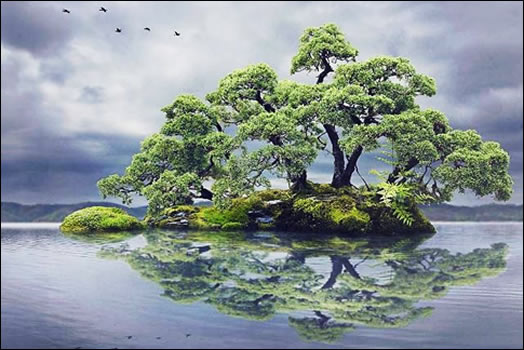
Inspiration for Art
In Japanese: ‘Yose-ue’ means forest group. Trees in nature are commonly found in groups.
Creating a bonsai forest (or group planting) usually involves an odd number of trees; this is in case a small number of trees are used, thus providing asymmetry. Most frequently the trees used are of the same species.
The greatest exponent of the art was Saburo Kato, whose book is internationally famous. A quote from the first and probably most well-known book on forest plantings first printed in English in 2001 by Bill Valavanis of USA.
“NATURE AT HAND
Forest bonsai is the type of bonsai that most expresses those intimate and deep emotions that we feel closest to ourselves. When we shut our eyes tightly and think back on when we were small, those ordinary scenes of woods or forests that we saw on those occasions when our teacher took us out on excursions seem wonderful. It is as if these scenes were alive and living in our memories, each a simple little version of nature with its peaceful, quiet feeling. We recall the changes in the four seasons and the freshness of the plants in nature that strive for beauty. For some reason these images will never be erased from our hearts but will remain forever.
Moreover, when we escape from the bustling life in the city and take a trip to the countryside, we are impressed by the tranquil scenes of mountains and forests visible from the car windows. The strong impression obtained through contact with the mysterious forests of the deep mountains is unforgettable. Forest bonsai is the art of taking these familiar aspects of nature and expressing them in a single tray or container. Viewing the forest bonsai in a tray calls to mind the gentle murmur of birds and connections to distant mountains, as well as of the sounds of a nearby gorge, of poetry and song, and of the expansion of boundless dreams. The most powerful impressions that we can call up from our encounters with nature thus become the basis for a growing adoration for the bonsai that we create.”
The spring season is the best time of year to create a group planting; the ideal time is when the trees you are combining into a forest planting are starting to show signs of new growth.
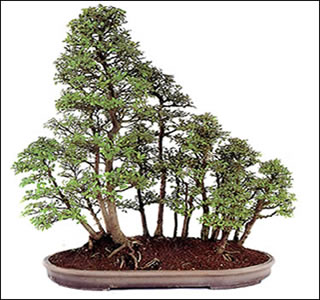
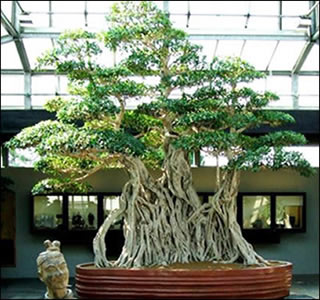
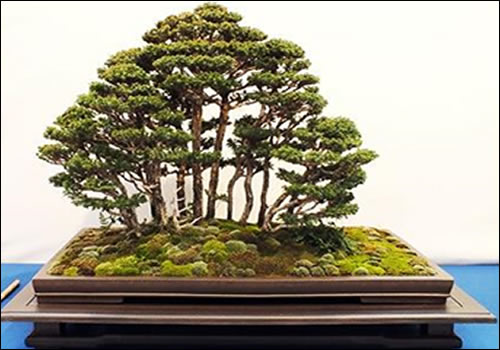
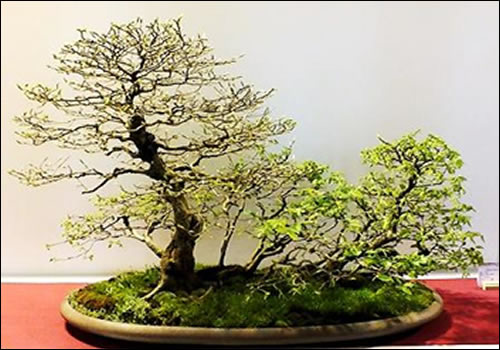
How to create a Bonsai forest planting
First of all suitable bonsai plants need to be selected; a group planting should consist of different sizes of trees, a few tall ones for in the middle and several smaller ones to plant on the sides. In nature forests grow from a central tree and spread outwards as new young trees grow from dropped seed, thus the younger, smaller treed are always on the outside edge. Use trees mostly growing upright, as the composition could look unnatural when using different shapes of trees. The number of trees used in total is your decision. The most difficult part of creating a forest planting is selecting and finding proper trees. Try to find trees of one species but varying in shape, size and trunk-thickness.
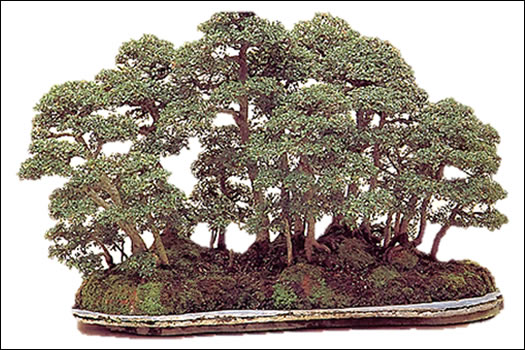
- Container, shallow; can be of any shape
- Trees of assorted heights and trunk diameter; they can be of one variety or mixed - it is a personal preference. They do need to be superb individual specimens.
- Accessory plants to create the landscape effect.
- Soil, an open spongy type with some grit (suitable for all types of trees).
- Wire to fasten trees in and for shaping.
- Gauze to cover holes.
- Rocks if you want it to be a natural landscape.
Selecting the right bonsai pot is very important; choose a large and quite shallow pot and take into account the normal guideline for deciding on colour etc.
- It should be shallow and have good drainage holes. It can be oval or rectangular or merely an irregular slab. You will need to prepare in advance.
- Cover the holes with gauze and fix in position.
- Ensure there are anchor points for the wires that you will use to secure the trees in place.
- Place a thin layer of grit across the whole container to ensure good drainage.
Use a standard Bonsai soil mixture of akadama, pumice and lava rock mixed together in a ratio of ½ to ¼ to ¼.
Preparing the container


- Select healthy well rooted trees, ensuring you have a range of heights and thickness of trunk, (shape is not too important as you can adapt it).
- Wire the entire tree before removing from its pot; make sure wires continue to the end of branches. It is essential that the wires are all firmly attached to the trunk thus ensuring the branches do not move and break off.
- Lift the tree from its pot, remove excess soil and untangle the roots. Trim off large unneeded roots and excess length - always leave enough to support the tree in good health. Make sure the tree does not dry out while you are working on it. Keep trees moist and covered until you are ready to use them.
- The focal point is where the eye will fosus first, it will then follow the drection of the group.
- The focal point is created by the tallest tree in the group,
- The tallest tree is usually also the thickest.
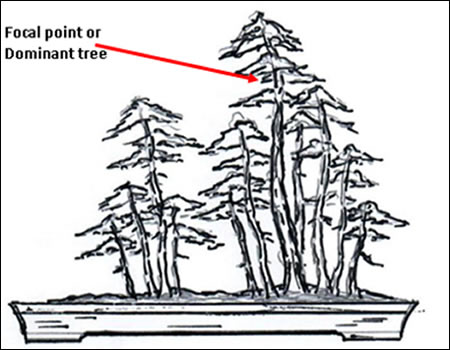
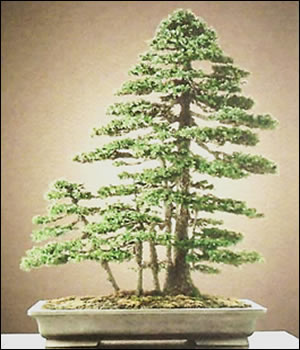
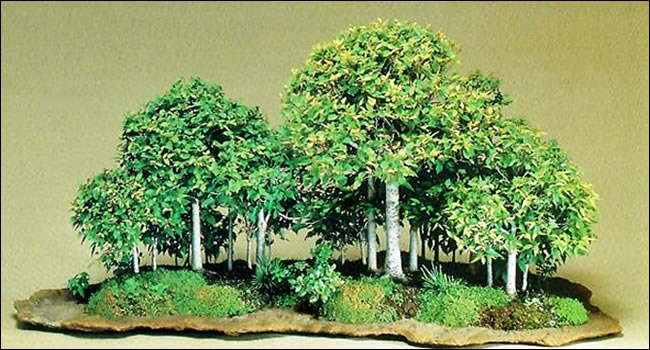
Two of Saburo Kato’s forests showing an obviously dominant focal tree. Arranging the trees is the next stage
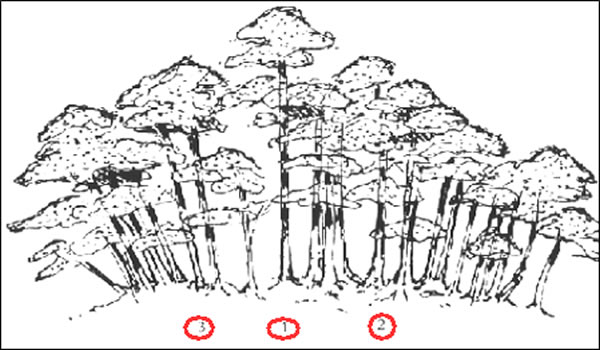
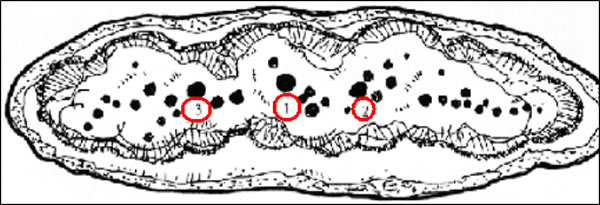
(1) Tallest tree, off and left of centre and slightly forward
(2) Off centre and slightly right & behind no. 1 and 3 (next tallest), left and slightly behind both 1 and 2 of the tallest tree. The direction has now been determined and more trees can be added.
View from above



Two possible layouts for groups of 7 trees: In each case the differences, although slight, will produce plantings very different in their final form. Seen from above and from front views.
The arrangements can then be completed with small companion plants and mosses, adding soil where required. Be sure to retain empty, negative space to retain the natural look.
One of the real advantages, especially to the beginner, is that forest plantings can look good with even the youngest, most immature specimens, provided they are well positioned and in sufficient quantities to produce a good canopy of foliage.
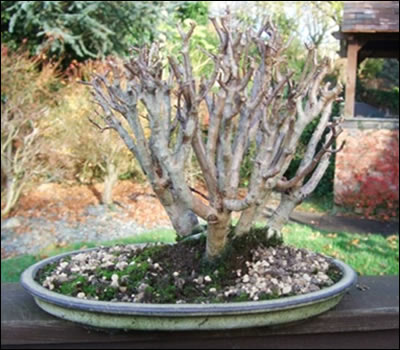
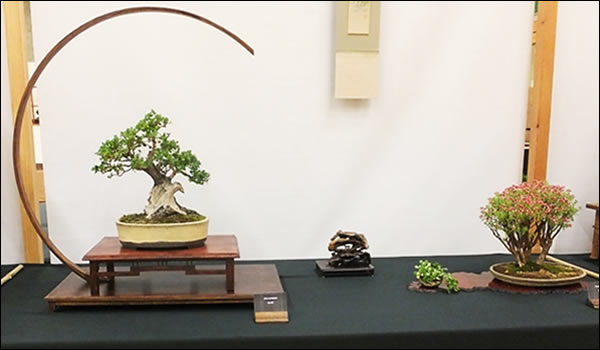
Above images: A very simple little Crassula group in flower; needs little training - just a hard cut back in autumn and as part of a display at Bonsai World 2015.

A much cherished Itoigawa juniper first put together by Martin Bradder and Gil Taylor Duxbury at “Joy of Bonsai” in 1996. Unfortunately I do not have a picture but initially, they were straight trees with little foliage. Later worked on by us with lots of onlooker “advice” and help with mountains of wiring. Used at “Bonsai Gold” in 1998 by Stuart Griffin who was doing a running demo to wire the whole group.
It has progressed well losing one or two trees on the way. Planned as a centre piece at South Staffs Bonsai Society display at Gardener’s World 2020; unfortunately Covid-19 cancelled the event; hopefully better luck in 2021.
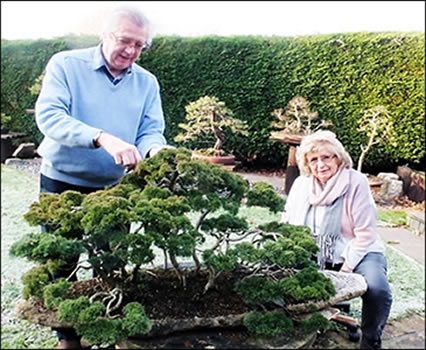
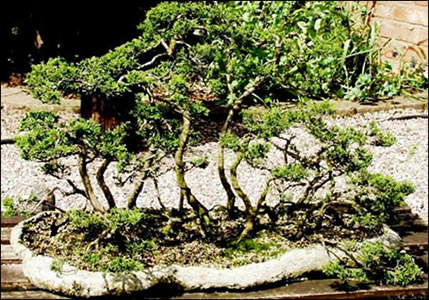
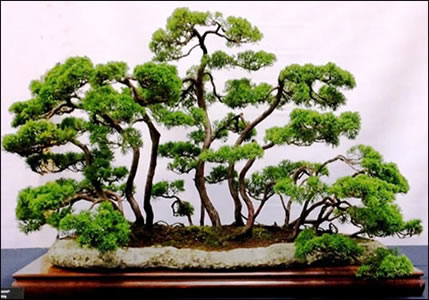

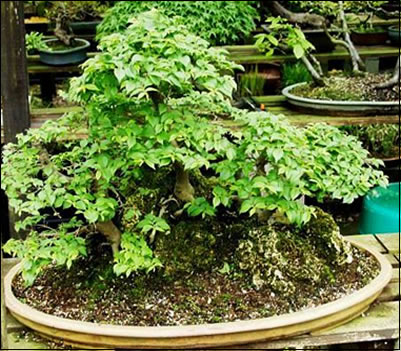
A rock planting of zelkova illustrating the changes due to refinement over an 11 year period.
2007 More tree and rock now visible - 2018
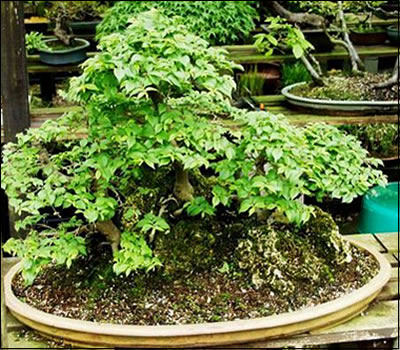

Mugo pine acquired from David Joyce’s garden rockery, planned to be a bonsai but never actually started following his death in 2000. The initial creation comprised a combined effort by Malcolm, Martin Bradder and Ken Norman. Followed by a lot of pruning, wiring, weeding, needle plucking and cutting arriving at the result we have today. It requires a lot of maintenance – it is very vigorous.
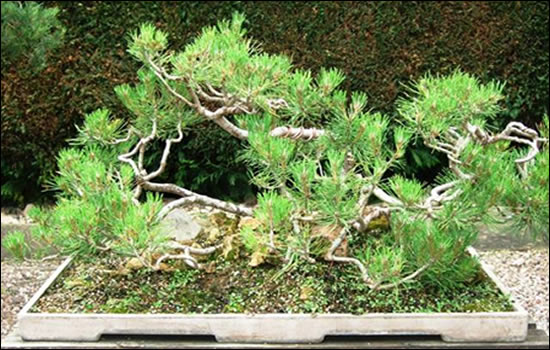
2005
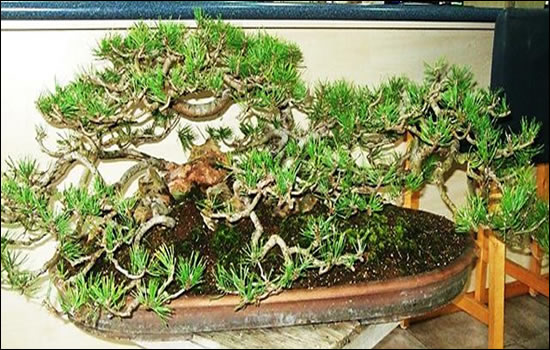
2019

A zelkova group from tiny cuttings created at the second Keele convention in 1983. It is vigorous but very slow to gain girth.
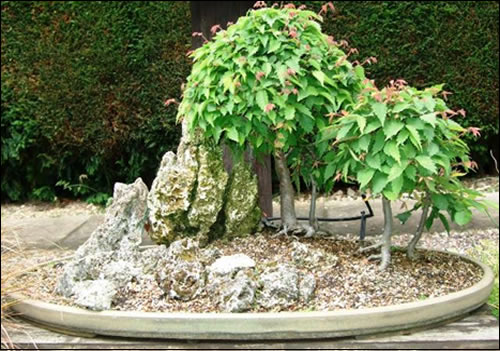

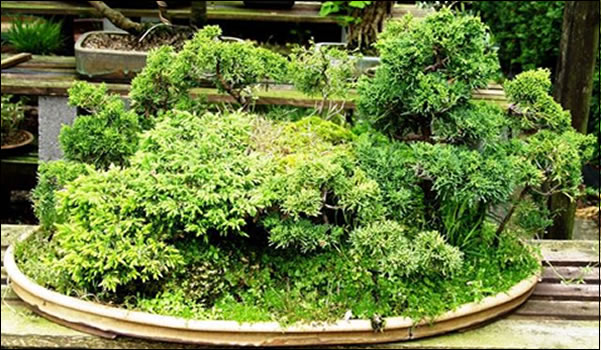
A mixed planting of junipers, gradually thinned out to reveal more of the rock structure.
2006 just planted by Martin Bradder
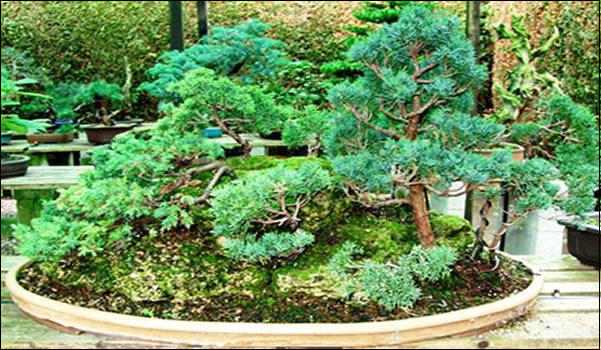
2 years later thinned down a little
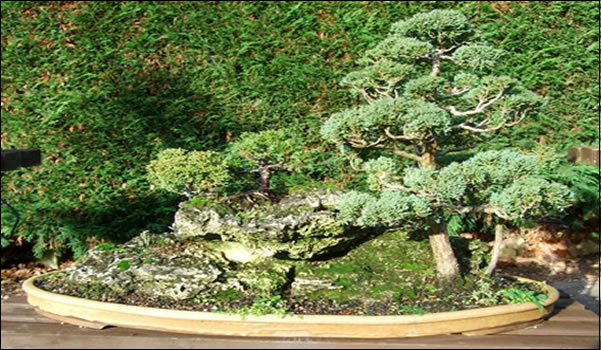
2020 rocks now showing; trees much reduced and trained.

Atlas cedar planting, transferred from pot to a home=made slab.
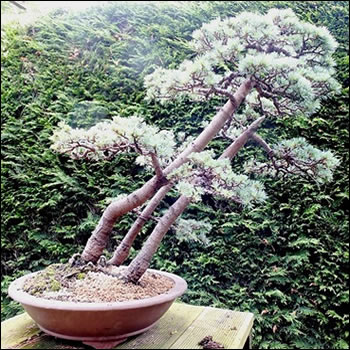
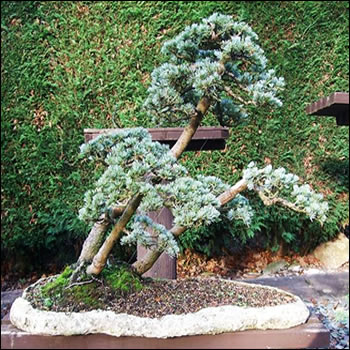

Two groups from Ken Norman’s collection.
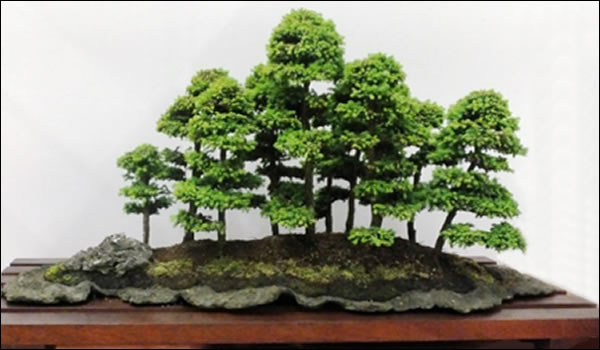
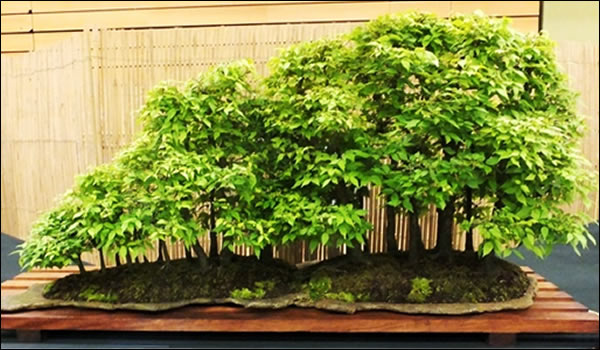

Typical Chinese Group of junipers
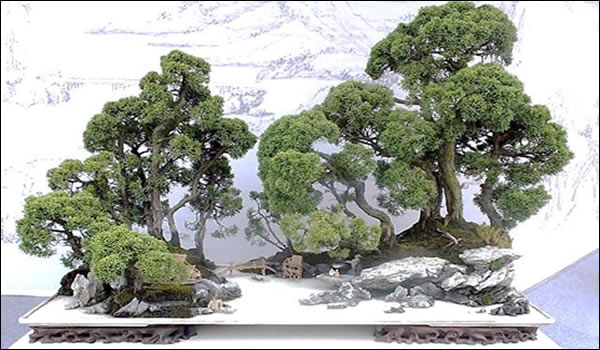
White pine group in Daizo Iwasaki’s garden, Takamatsu, Japan
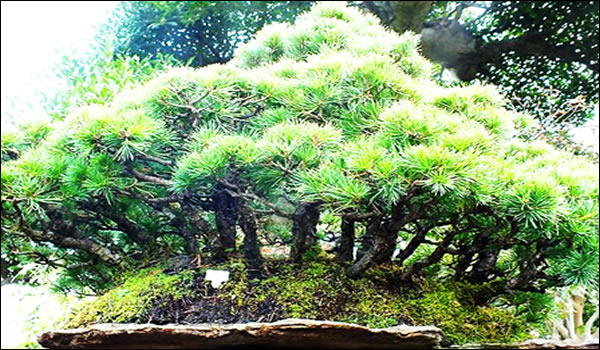
China - an example of the size of some of their groups – this does reflect the origins of bonsai when the Chinese first had them as “patio” plants.
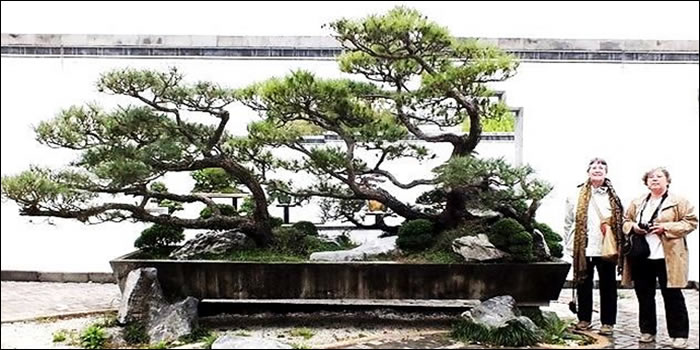
Web design: nysys
